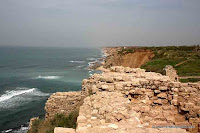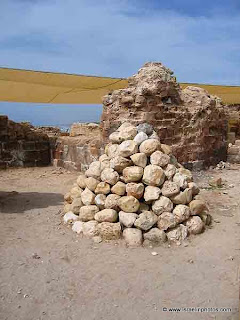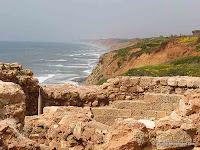The site of Apollonia-Arsuf lies on the Mediterranean coast of Israel on a cliff overlooking a natural anchorage between Jaffa and Caesarea.
Arsuf was settled in the 6th or 5th century BCE, and was known as Arsuf (the name comes from Reshef, the Canaanite-Phoenician god of fertility and the underworld). From the Late Hellenenistic period onward it became the chief commercial and industrial centre of the southern Sharon Plain; it was renamed Apollonia, as the Greeks identified Reshef with Apollo. Josephus mentions Apollonia in his list of cities, which belonged to the Jews under Alexander Yanneus. Arsuf grew in size as the result of its production of purple dye, which it exported to the Roman Empire. It was an important settlement between Jaffa and Caesarea along the Via Maris. In the 5th and 6th century CE (Byzantine period) it was the second largest city in the Sharon valley, after Caesarea, populated by Christians and Samaritans. They had a prosperous glass industry. In 640 CE the town was captured by Muslims and the name was restored to Arsuf; the city decreased.
In 1101 Arsuf fell to a Crusader army led by Baldwin I of Jerusalem. The Crusaders, who called it Arsur, rebuilt the city's walls and created the Lordship of Arsur in the Kingdom of Jerusalem. In 1187 Arsuf was captured by the Muslims, but fell again to the Crusaders on September 7, 1191 after a battle between Richard I of England and Saladin.
John of Ibelin, Lord of Beirut (1177-1236) became Lord of Arsur in 1207 when he married Melisende of Arsur (born c.1170). Their son John of Arsur (c.1211-1258) inherited the title. The title then passed to John of Arsur's eldest son Balian (1239-1277). He built new walls, the big fortress and new harbor (1241). From 1261, the city was ruled by the Knights Hospitaller.
In 1265 sultan Baibars, ruler of the Mamluks, captured Arsur, after 40 days of siege. The Mamluks razed the city walls and the fortress to their foundations, fearing a return of the Crusaders. The destruction was so complete that the site has not been resettled since.















